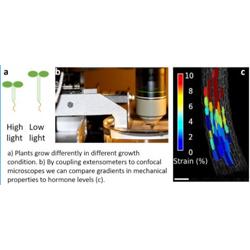Supervisor
Dr Sarah Robinson
Project outline
The size and shape of plant organs are of fundamental importance to their function. They also regulate yield and susceptibility to biotic and abiotic stress. In order for a tissue to obtain its form, it must undergo a physical deformation, which occurs as a result of networks of genes acting to alter the mechanical properties of parts of the tissue. The mechanical properties of the tissue can also be changed in response to its physical environment or disease; altering the final form of the organism. In addition, many of the proteins, protein polymers, and signalling networks that control the mechanical properties are sensitive to mechanical stresses that build up during development, for example, altering their orientation in response to the stress direction thus feeding back on to the process of development itself. The relative contribution of mechanical stress sensing versus hormonal regulation is unclear and is something that the Robinson lab would like to address.
In response to changing environmental conditions plants alter their growth and their cellular patterning. We will investigate the relative contribution of hormones and mechanical feedback on these processes. The project uses biomechanical tools such as atomic force microscopy (AFM) and an automated confocal micro-extensometer (ACME) to quantify mechanical properties in living cells.
Preliminary results from the lab suggest that lines with different cell division frequencies have altered abilities to change their growth rate. We will investigate the extent to which this is a result of mechanical constraints and feedback, versus hormonal regulation. This will be achieved by measuring the mechanical properties of the tissues in the different conditions and combining this with biosensors to quantify hormone levels. This is an interdisciplinary project where the candidate will learn to use genetic, biomechanical and image analysis tools. Where there is sufficient interest the candidate can also work to build an integrated mechanical model of plant growth.

